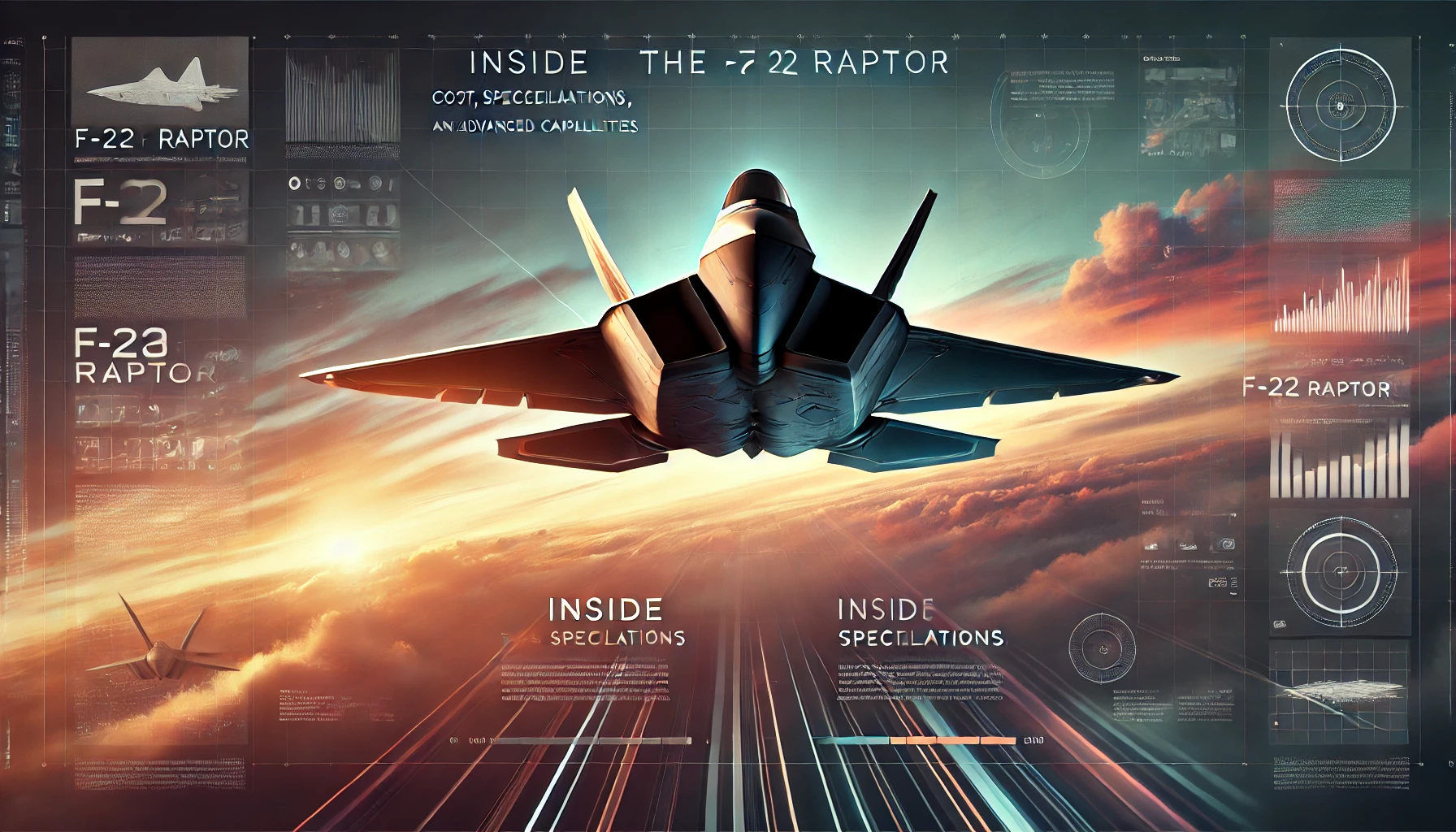F-22 Raptor: Cost, Specifications, and Advanced Capabilities
The F-22 Raptor is a marvel of modern aviation, often hailed as one of the most advanced fighter jets ever built. As a cornerstone of the U.S. Air Force’s air dominance strategy, the F-22 combines stealth, speed, agility, and advanced avionics to deliver unparalleled performance in combat situations. This blog will explore the F-22 Raptor’s cost, specifications, speed, stealth features, and armament, offering a comprehensive look at why this aircraft is considered a game-changer in modern warfare.
The Cost of the F-22 Raptor: Is It Worth the Investment?
One of the most discussed aspects of the F-22 Raptor is its cost. With a price tag that can make even the most seasoned defense analysts take a deep breath, the F-22 is one of the most expensive fighter jets ever produced.
Acquisition and Development Costs
The F-22 Raptor program began in the late 1980s as part of the Advanced Tactical Fighter (ATF) program. The goal was to develop a fighter jet that could maintain air superiority well into the 21st century. The initial cost of each F-22 was approximately $150 million, but when research and development, as well as upgrades, are factored in, the total cost per aircraft skyrockets to nearly $350 million (Joint Base Langley-Eustis).
- Development Costs: The total cost of the F-22 program is estimated to be around $66.7 billion, which includes the cost of research, development, and procurement. This figure also covers the production of 195 aircraft, of which 187 were operational (Joint Base Langley-Eustis).
- Operational Costs: The F-22 is not only expensive to build but also to maintain. The cost per flight hour for the F-22 is estimated at $68,000, significantly higher than that of other fighter jets. This high operational cost is due to the advanced materials and technologies used in the aircraft, which require specialized maintenance (Joint Base Langley-Eustis).
Is It Worth the Cost?
While the F-22’s cost is undeniably high, its capabilities justify the investment. The F-22 provides the U.S. Air Force with unmatched air superiority, thanks to its combination of stealth, speed, and firepower. This ensures that the U.S. can maintain air dominance in any combat scenario, making the F-22 a critical asset in modern warfare.
Specifications: A Closer Look at the F-22 Raptor’s Capabilities
The F-22 Raptor is a fifth-generation fighter jet that excels in multiple areas, from stealth and speed to avionics and armament. Here’s a detailed look at the specifications that make the F-22 a formidable force in the skies.
Key Specifications
- Length: 62 feet 1 inch (18.90 meters)
- Wingspan: 44 feet 6 inches (13.56 meters)
- Height: 16 feet 8 inches (5.08 meters)
- Maximum Takeoff Weight: 83,500 pounds (37,875 kilograms)
- Range: Approximately 1,839 miles (2,960 kilometers) without refueling
- Service Ceiling: 65,000 feet (19,812 meters)
These specifications highlight the F-22’s ability to operate at high altitudes and long ranges, making it suitable for a variety of missions, from air-to-air combat to ground attack operations.
Avionics and Technology
The F-22 is equipped with state-of-the-art avionics that provide the pilot with unparalleled situational awareness. This includes:
- AN/APG-77 Radar: The F-22’s radar system is one of its most advanced features. It offers long-range target detection and tracking, as well as ground mapping capabilities. The radar is designed to reduce the likelihood of detection by enemy forces, thanks to its low probability of intercept (LPI) features (Joint Base Langley-Eustis).
- Integrated Avionics: The F-22’s avionics are fully integrated, allowing for seamless communication between the aircraft’s sensors, navigation systems, and weapons. This integration enhances the pilot’s ability to make quick, informed decisions in combat situations (Joint Base Langley-Eustis).
Speed and Agility: The Raptor’s Performance in the Sky
The F-22 Raptor is known for its incredible speed and agility, both of which are critical for success in air combat.
Supercruise Capability
One of the standout features of the F-22 is its ability to supercruise, or maintain supersonic speeds without the use of afterburners. This allows the F-22 to fly faster for longer periods while conserving fuel and maintaining stealth. The F-22 can cruise at speeds greater than Mach 1.8, making it one of the fastest fighter jets in the world (Joint Base Langley-Eustis).
Maneuverability
The F-22’s agility is unmatched, thanks to its thrust vectoring nozzles and aerodynamic design. These features allow the F-22 to perform sharp turns and maneuvers at high speeds, giving it a significant advantage in dogfights. The aircraft’s agility is further enhanced by its fly-by-wire control system, which provides the pilot with precise control over the aircraft’s movements (Joint Base Langley-Eustis).
Stealth Features: Evading Detection
Stealth is a critical component of the F-22’s design, allowing it to operate undetected in hostile environments.
Radar-Absorbent Materials (RAM)
The F-22’s airframe is covered in radar-absorbent materials that reduce its radar cross-section (RCS). These materials, combined with the aircraft’s stealthy design, make the F-22 nearly invisible to enemy radar systems. The F-22’s RCS is estimated to be about the size of a marble, making it extremely difficult to detect even by advanced radar systems (Joint Base Langley-Eustis).
Low-Observable Design
The F-22’s design features sharp angles and flat surfaces that deflect radar waves away from the source. This low-observable design is complemented by the aircraft’s internal weapons bays, which eliminate the need for external hardpoints that could increase the RCS (Joint Base Langley-Eustis).
Armament: The F-22’s Lethal Arsenal
The F-22 Raptor is equipped with a wide range of armament, allowing it to engage multiple targets in both air-to-air and air-to-ground combat.
Air-to-Air Armament
- AIM-120 AMRAAM: The F-22 can carry up to six AIM-120 Advanced Medium-Range Air-to-Air Missiles (AMRAAM) in its internal weapons bays. These missiles are designed for beyond-visual-range (BVR) engagements, allowing the F-22 to destroy enemy aircraft from a distance (Joint Base Langley-Eustis).
- AIM-9 Sidewinder: The F-22 also carries two AIM-9 Sidewinder missiles, which are short-range, heat-seeking missiles ideal for close-quarters dogfights. These missiles are housed in the F-22’s side weapons bays, ensuring that the aircraft’s stealth capabilities are maintained until the missiles are deployed (Joint Base Langley-Eustis).
Air-to-Ground Armament
- JDAMs: The F-22 is capable of carrying Joint Direct Attack Munitions (JDAMs), which are precision-guided bombs designed for ground attack missions. The F-22’s ability to carry JDAMs enhances its versatility, allowing it to engage both aerial and ground targets with precision (Joint Base Langley-Eustis).
20mm Vulcan Cannon
In addition to its missiles and bombs, the F-22 is equipped with a 20mm M61A2 Vulcan cannon, which is housed internally to maintain the aircraft’s stealth profile. This six-barrel rotary cannon can fire up to 6,000 rounds per minute, making it highly effective in close-range combat (Joint Base Langley-Eustis).
Conclusion: The F-22 Raptor’s Strategic Importance
The F-22 Raptor is more than just a fighter jet; it is a symbol of technological superiority and military strength. Its cost is justified by its unmatched specifications, speed, stealth features, and armament. The Raptor provides the U.S. Air Force with the capability to dominate the skies in any combat scenario, ensuring air superiority for decades to come.
As we look to the future, the F-22 will continue to play a crucial role in U.S. military operations, with ongoing upgrades ensuring that it remains at the cutting edge of aviation technology. For more insights into the F-22 Raptor and other advancements in military technology, visit Regent Studies.
In summary, the F-22 Raptor exemplifies the pinnacle of modern aviation, with its combination of stealth, speed, agility, and firepower. Whether you’re fascinated by its specifications, impressed by its armament, or intrigued by its stealth features, the F-22 remains a critical component of the United States’ air defense strategy.




